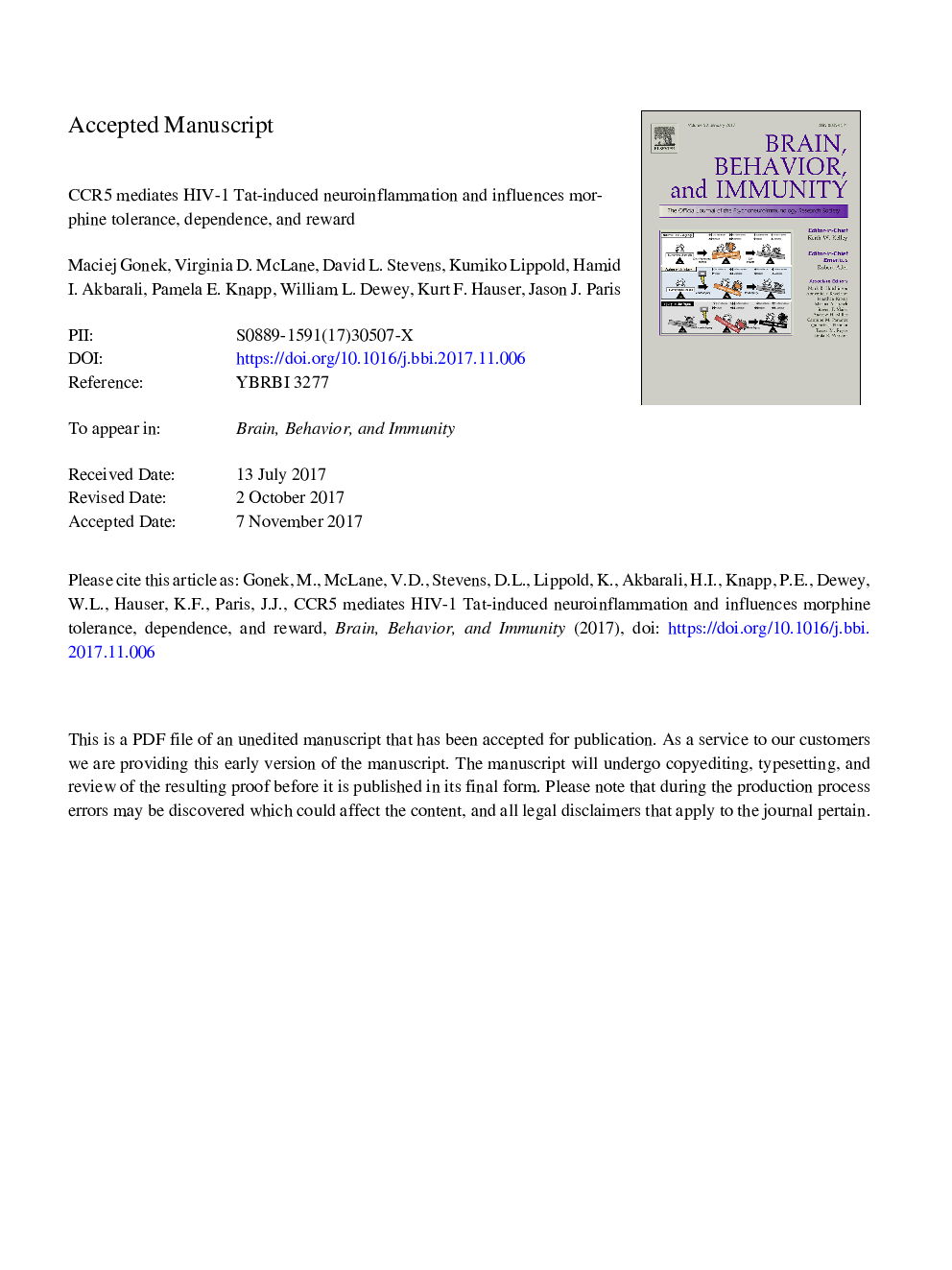| کد مقاله | کد نشریه | سال انتشار | مقاله انگلیسی | نسخه تمام متن |
|---|---|---|---|---|
| 7279378 | 1473897 | 2018 | 61 صفحه PDF | دانلود رایگان |
عنوان انگلیسی مقاله ISI
CCR5 mediates HIV-1 Tat-induced neuroinflammation and influences morphine tolerance, dependence, and reward
دانلود مقاله + سفارش ترجمه
دانلود مقاله ISI انگلیسی
رایگان برای ایرانیان
کلمات کلیدی
موضوعات مرتبط
علوم زیستی و بیوفناوری
ایمنی شناسی و میکروب شناسی
ایمونولوژی
پیش نمایش صفحه اول مقاله

چکیده انگلیسی
The HIV-1 regulatory protein, trans-activator of transcription (Tat), interacts with opioids to potentiate neuroinflammation and neurodegeneration within the CNS. These effects may involve the C-C chemokine receptor type 5 (CCR5); however, the behavioral contribution of CCR5 on Tat/opioid interactions is not known. Using a transgenic murine model that expresses HIV-1 Tat protein in a GFAP-regulated, doxycycline-inducible manner, we assessed morphine tolerance, dependence, and reward. To assess the influence of CCR5 on these effects, mice were pretreated with oral vehicle or the CCR5 antagonist, maraviroc, prior to morphine administration. We found that HIV-1 Tat expression significantly attenuated the antinociceptive potency of acute morphine (2-64â¯mg/kg, i.p.) in non-tolerant mice. Consistent with this, Tat attenuated withdrawal symptoms among morphine-tolerant mice. Pretreatment with maraviroc blocked the effects of Tat, reinstating morphine potency in non-tolerant mice and restoring withdrawal symptomology in morphine-tolerant mice. Twenty-four hours following morphine administration, HIV-1 Tat significantly potentiated (â¼3.5-fold) morphine-conditioned place preference and maraviroc further potentiated these effects (â¼5.7-fold). Maraviroc exerted no measurable behavioral effects on its own. Protein array analyses revealed only minor changes to cytokine profiles when morphine was administered acutely or repeatedly; however, 24â¯h post morphine administration, the expression of several cytokines was greatly increased, including endogenous CCR5 chemokine ligands (CCL3, CCL4, and CCL5), as well as CCL2. Tat further elevated levels of several cytokines and maraviroc pretreatment attenuated these effects. These data demonstrate that CCR5 mediates key aspects of HIV-1 Tat-induced alterations in the antinociceptive potency and rewarding properties of opioids.
ناشر
Database: Elsevier - ScienceDirect (ساینس دایرکت)
Journal: Brain, Behavior, and Immunity - Volume 69, March 2018, Pages 124-138
Journal: Brain, Behavior, and Immunity - Volume 69, March 2018, Pages 124-138
نویسندگان
Maciej Gonek, Virginia D. McLane, David L. Stevens, Kumiko Lippold, Hamid I. Akbarali, Pamela E. Knapp, William L. Dewey, Kurt F. Hauser, Jason J. Paris,